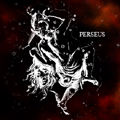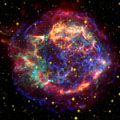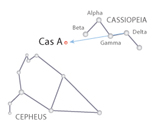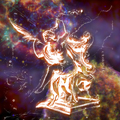An overview of the Chandra mission and goals, Chandra's namesake, top 10 facts.
Classroom activities, printable materials, interactive games & more.
Overview of X-ray Astronomy and X-ray sources: black holes to galaxy clusters.
All Chandra images released to the public listed by date & by category
Current Chandra press releases, status reports, interviews & biographies.
A collection of multimedia, illustrations & animations, a glossary, FAQ & more.
A collection of illustrations, animations and video.
Chandra discoveries in an audio/video format.
Fall Constellations: A Royal Family Reunion in the Chilly Night Sky
October 25, 2005 ::
 |
Artistic representation of a part of Johannes Hevelius' URANOGRAPHIA (1690).
(Illustration: CXC)
|
| Locate Cas A in the Sky |

Cassiopeia A
|
|
Your guide stars are delta and gamma Cassiopeia. Imagine the line which connects these two stars and extend this imaginary line from delta to gamma, but three times that distance past gamma. Aim your telescope a hair south of that point to view the location of Cas A.
|

|
|
During the autumn months, a royal family of constellations is reunited in
the night sky of the northern hemisphere. Cassiopeia and Cepheus, in close
proximity to the North Star and thus never disappearing entirely from view,
are joined by the newly rising Andromeda, Perseus and Pegasus
constellations. Greek mythology gives a dramatic interpretation to these
stellar patterns, as Chandra gives dramatic insight into the objects
contained within them.
According to Greek mythology, ancient Aethiopia was ruled by the beautiful
Queen Cassiopeia and her husband, King Cepheus. Queen Cassiopeia's
legendary beauty was matched only by her great vanity, leading her to make
a number of brash comparisons. She pronounced herself the fairest in all
the kingdom, in all the world, finally proclaiming her beauty to be greater
than that of the exquisite Sea-Nymphs (or Nereids), daughters of the sea
god Poseidon, renowned for their loveliness and grace.
Her boast was quickly met with anger and vengeance, as Poseidon, acting at
his daughters' behest, sent a ferocious sea monster to ravage the coast of
Aethiopia. King Cepheus, desperate to appease the deity, consulted with an
oracle who directed him to sacrifice his lovely young daughter Andromeda to
the monster's appetite.
Andromeda was tied with chains to an ocean cliff, left to be devoured by
the monster. She was spied by Perseus, son of Jupiter, returning from his
successful venture to kill the serpent-haired Medusa (the white winged horse Pegasus sprang fully formed from Medusa's dead body). The sight of the beautiful maiden tied to her rock, pale and
terrified, with the sea-monster fast approaching, impelled him to kill the
monster and save her life. Perseus had obtained the King and Queen's
consent to marry the princess, thus joining himself to the royal family of
Aethiopia.
Queen Cassiopeia regained sufficient honor in her lifetime to be placed in
the sky upon her death, the starred Aethiopian Queen sitting forever on her
throne. The Sea-Nymphs' anger had not subsided, however, and they requested
that she be placed near the north pole so that she spend half of the night
hanging upside down, as a lesson in humility.
 |
The stars that make up the constellations and many of the sources that Chandra observes are at very different distances from Earth.
(Illustration: CXC)
|
Given this background, the constellation Cassiopeia appropriately features
one of the brightest and most beautiful supernova remnants ever observed,
Cas A, as well as
Tycho's SNR and the
SNR 3C58.
King Cepheus, with his crown, is located next to Cassiopeia on the sky and
contains the planetary nebula
NGC 40, a dying, Sun-like star
surrounded by hot gas and winds.
Princess Andromeda, still bound to an ocean cliff, is home to our closest
spiral galaxy, the
Andromeda Galaxy or M31, as well as the
flickering black holes and neutron stars seen in the galaxy
NGC 1637.
Andromeda's husband Perseus, found next to her with his sword drawn,
harbors the immense Perseus galaxy cluster. The supermassive black hole
found in the center of the cluster is emitting what appears to be sound
waves, producing the
lowest note ever found in nature.
The winged white horse Pegasus, separated from Perseus by Princess
Andromeda, contains the tumultuous group of galaxies known as
Stephan's
Quintet, the giant galaxy cluster
Abell 2390, the mysterious
neutron star systems in the globular cluster
M15, and a rare type of
supermassive black hole known as a
Type 2 quasar.
Stay tuned for the myths and images of the Winter Constellations.








